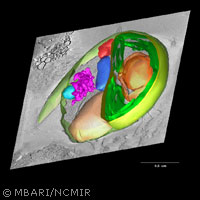Green genes provide insights into climate change
An international team of researchers has decoded genomes of two strains of algae that grow in very different parts of the ocean, and have gained new insights into the genes that enable them to capture carbon. Their findings, published in the journal Science, shed light on ancient cellular processes that have implications for the study of climate change and the development of algae-derived biofuels. The marine algae Micromonas are about one fiftieth of the width of a human hair, and thrive in both tropical and polar waters. They capture CO2, sunlight, water, and nutrients to produce carbohydrates and oxygen throughout the world's oceans. They provide an important source of food and sequester carbon, which makes them the focus of intensive investigation. In the current study, the researchers sampled two types of Micromonas: one from the South Pacific and another from the English Channel. Genetic analysis identified approximately 10,000 genes in each and revealed that the 2 strains had diverged dramatically. 'Surprisingly, they are far more diverse than we originally thought,' said lead author Alexandra Worden of the Monterey Aquarium Research Institute in the US. 'These two picoeukaryotes [the group to which Micromonas belongs], often considered to be the same species, only share about 90% of their genes.' A 10% difference might not seem like a lot, but keep in mind that humans and some primates have about 98% of their genes in common. The different genes in these two strains of Micromonas, Dr Worden said, may cause them to respond to the environment differently. 'This also means that as the environment changes, these different populations will be subject to different effects, and we don't know whether they will respond in a similar fashion,' she explained. Together with genomic data from previous studies, the new information about the genetic code of the photosynthetic algae also provides insights into how photosynthesis transformed the Earth into a life-sustaining biosphere. 'The Micromonas genomes encapsulate features that now appear to have been common to the ancestral algae that initiated the billion-year trajectory that led to the "greening"' - the rise of land plants - of the planet,' said Dr Worden. Picoeukaryotes are extremely productive and are subject to heavy grazing pressure. They play an important role in the carbon sequestration process as part of the 'biological pump', or series of events that enable algae to capture atmospheric carbon and transport it from the surface to the ocean floor. The new knowledge can be compared with genomic information from other algal and plant genomes, which can help to draw a clearer picture of the dynamic nature of evolutionary processes, the researchers say. It should also provide insights that will lead to understanding the complex functional nature of phytoplankton populations in general. The algae's ability to adapt to a wide range of environments may have resulted in its becoming much more resilient than similar species, Dr Worden speculates. This would enable them to weather environmental change better than algae that can thrive only in a narrow geographic range. Further testing this idea will, the researchers believe, go a long way towards understanding the biology and ecology of these important organisms. 'By understanding which genes a specific strain employs under certain conditions, we gain a view into the factors that influence the success of one group over another,' said Dr Worden. 'We may then be able to develop models that could more effectively predict a range of possible future scenarios that will result from current climate change.' The study was carried out by researchers in Belgium, France, Germany, the Netherlands, Norway, Australia and the US.
Countries
France, United States



